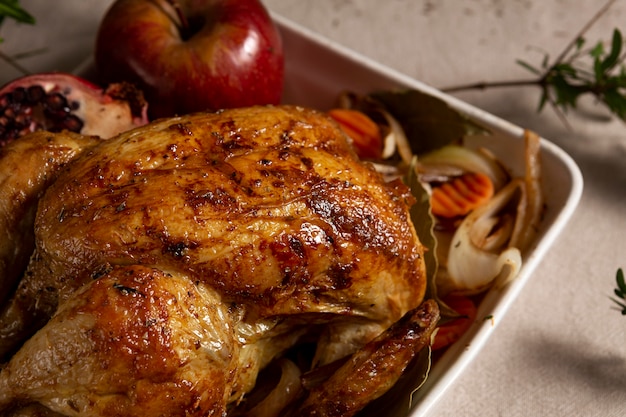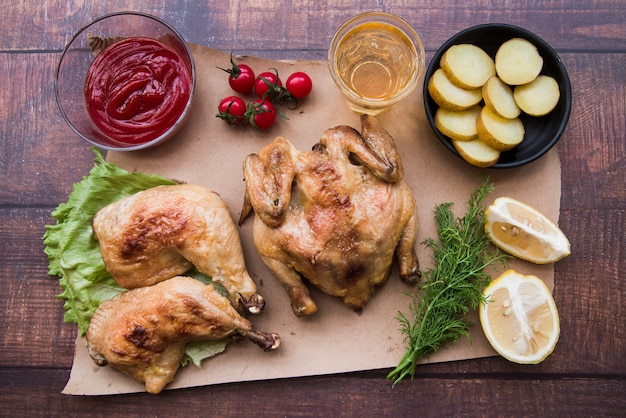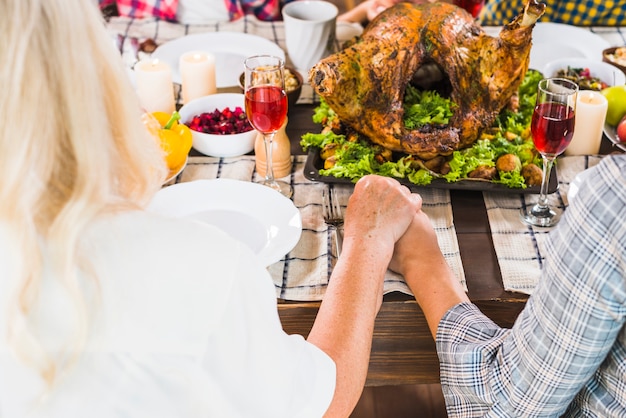(Part 1) Choosing the Right Chuck Roast

Let's start at the beginning - picking the perfect chuck roast. It's a cut that comes from the shoulder of the cow, and it's known for being a bit tougher than some other cuts. That's why it needs a little extra love to become melt-in-your-mouth delicious. Here's what to look for:
Look for a Good Marble
The first thing to check is the marbling. That's the fat that runs throughout the meat. Think of it like the "jewels" in the crown of your roast. You want to see a good amount of marbling, it's what gives the roast its flavour and helps it stay juicy during cooking. Imagine biting into a beautifully marbled chuck roast—the fat melts in your mouth, adding a richness that just can't be replicated. If you can't find a nicely marbled chuck roast, don't worry! A good butcher can usually trim a leaner cut to get you a bit more fat in there. And, remember, fat equals flavour!
Don't Forget to Check the Weight
You'll also want to consider the weight of the roast. You can usually find chuck roasts ranging from 2-4 pounds. For a family meal, a 3-pound roast is usually a good size. It's a good rule of thumb to figure out how many people you're feeding and adjust the weight accordingly. Remember, the larger the roast, the longer it will take to cook.
(Part 2) Preparing the Chuck Roast

Now, the fun part - getting that chuck roast ready for the oven. I always find this bit satisfying, like getting things in order before starting a project. Here's what I do:
Trimming the Excess
First, I trim any excess fat from the roast. It's a good idea to leave a thin layer, it'll help keep the meat moist. But I tend to remove any big clumps of fat, they don't really contribute much to the flavour and can make the roast a bit greasy. Think of it like tidying up a bit before starting a project. The less excess fat, the less chance of a messy, greasy situation in the pan.
Seasoning to Perfection
Next, I season the roast with my go-to mix of salt, pepper, and a generous helping of garlic powder. I also like to use a little onion powder and dried herbs, but that's totally up to your taste. The key is to get a good even layer of seasoning on all sides of the roast. It's like a little hug of flavour for the roast. You want to make sure every corner gets a little love.
Adding a Little Extra
I've found that adding a bit of a flavorful base really elevates the chuck roast. My favourite trick is to rub a paste made from Dijon mustard, garlic, and herbs onto the roast. It gives it a delicious crust and adds another layer of flavour. A bit of Worcestershire sauce also does wonders, adding that savory depth. It's like building a flavour profile, layer by layer. The Dijon mustard adds a tangy kick, while the garlic and herbs create a fragrant aroma. The Worcestershire sauce brings a complex depth to the whole thing.
(Part 3) Oven Cooking Time: Finding the Right Temperature

Okay, now we're getting to the heart of the matter. The oven cooking time for chuck roast is really important, and it depends on the size of the roast and the desired level of doneness. I've learned that it's best to cook chuck roast at a lower temperature, around 325°F (160°C), to get that perfect melt-in-your-mouth tenderness. Imagine a slow, gentle embrace of heat, coaxing out the best in your chuck roast. Here's a general guide for cooking time:
Chuck Roast Oven Cooking Time Chart
Here's a table that shows you the approximate cooking time for chuck roast based on its weight:
| Weight (pounds) | Approximate Cooking Time (hours) |
|---|---|
| 2 | 2-2.5 |
| 3 | 2.5-3 |
| 4 | 3-3.5 |
Remember, this is just a general guide, you'll need to check the internal temperature of the roast to make sure it's cooked through.
(Part 4) Checking the Doneness
Checking the internal temperature is crucial, you don't want to end up with a roast that's undercooked or dry. I always use a meat thermometer to make sure the chuck roast is cooked to my liking.
The Ideal Temperature
The USDA recommends an internal temperature of 145°F (63°C) for a safe and delicious chuck roast. For a more tender and juicy roast, you might want to aim for an internal temperature of 150°F (66°C). But, again, this is just a guideline, your personal preference plays a role. Think of the meat thermometer as your trusted guide, making sure your roast is cooked to your exact liking.
How to Check the Temperature
To check the internal temperature, insert the meat thermometer into the thickest part of the roast, making sure not to touch the bone. If you're using a digital thermometer, wait for the reading to stabilize before taking it out. Imagine the thermometer as a little detective, exploring the heart of your roast to reveal its secrets.
Don't Forget to Rest the Roast
Once the roast is cooked to your desired temperature, take it out of the oven and let it rest for 15-20 minutes before slicing. This allows the juices to redistribute throughout the roast, resulting in a more tender and flavorful final product. Think of it as giving the roast a little break, a chance to settle in and absorb all the deliciousness.
(Part 5) The Magic of slow cooking
Now, let's talk about slow cooking. I love using the slow cooker for chuck roast, it just brings out the best in it. It's all about those low and slow temperatures, resulting in the most tender, melt-in-your-mouth roast you could ever imagine. Imagine a slow, gentle simmer, transforming your chuck roast into a symphony of flavors. Here's how I approach slow-cooking chuck roast:
Choosing the Right Slow Cooker
First, you'll need a slow cooker, and trust me, it's an investment you won't regret. I've got a trusty 6-quart slow cooker, it's the perfect size for cooking a 3-4 pound chuck roast. It's like your trusty sidekick in the kitchen, always ready to work its magic.
Preparing the Roast
Then, it's time to get your roast ready. I tend to brown it in a pan before adding it to the slow cooker, it really adds depth of flavour. This step is optional, but I highly recommend it. Think of it as a little extra love before sending your roast off to the slow cooker. It's like a warm welcome for your roast, creating a delicious base for the slow-cooking journey.
Choosing the Right Settings
I usually set my slow cooker to "low" for 6-8 hours, but you can also cook it on "high" for 4-6 hours. Again, it depends on the size of the roast and your preference for how tender you want it. It's all about finding that perfect balance, like tuning a radio to the perfect station. You want to find the setting that will bring out the best in your roast.
Adding Liquids and Flavours
Don't forget about the liquids! A good slow cooker chuck roast needs a flavorful broth or sauce. I like to use a combination of beef broth, red wine, and my favourite herbs and spices. Imagine a rich, flavorful bath for your roast, nourishing it and adding a symphony of aromas. It's like a comforting embrace of flavour, enhancing the roast's natural beauty.
(Part 6) Serving Up Your Masterpiece
Alright, your chuck roast is cooked to perfection, and now it's time to enjoy the fruits of your labor! Here's how I like to serve it up:
Slicing Up the Roast
Once the roast has rested, slice it against the grain. This helps to break down the muscle fibers, resulting in a more tender cut. Think of it as revealing the beautiful texture within the roast, making every bite a delight. It's like opening a beautifully wrapped gift, revealing a masterpiece inside.
Sides That Sing
The best part about chuck roast is its versatility! It pairs beautifully with a variety of sides. I love serving it with roasted vegetables, mashed potatoes, creamy polenta, or a hearty salad. Imagine your chuck roast as a conductor, leading a symphony of flavours. Every side plays a role, creating a harmonious culinary experience. It's like finding the perfect partners for a fantastic performance.
Sauce It Up
If you want to add a little extra zing, make a simple pan sauce with the drippings from the roast. Just deglaze the pan with a little red wine or beef broth, and simmer until thickened. It's like adding a final touch of brilliance to your masterpiece. The pan sauce brings a burst of flavor, adding a touch of elegance and sophistication.
(Part 7) Leftovers That Delight
You know what they say, leftovers are the best! A perfectly cooked chuck roast will be even more delicious the next day. Here's how I like to use my leftovers:
A Delicious Sandwich Filling
One of my favourite uses for leftover chuck roast is in sandwiches. Just pile some slices on a crusty roll with a dollop of horseradish mayo and a few crunchy pickles. It's a simple and satisfying meal. Imagine a comforting sandwich, filled with the rich flavors of a perfectly cooked chuck roast. It's a perfect way to repurpose those leftovers into a new culinary adventure. It's like a delicious second act for your roast.
Hearty Soups and Stews
Another great option is to use the leftover roast in soups or stews. It adds a wonderful depth of flavour and makes them incredibly filling. Just shred the roast and add it to your favourite recipe. Imagine a hearty, comforting soup, filled with the tender chunks of chuck roast. It's a perfect way to stretch those leftovers into a warming meal. It's like transforming your roast into a new culinary masterpiece.
A Quick and Easy pasta dish
Finally, I love making a quick and easy pasta dish with leftover chuck roast. Just toss it with some cooked pasta, a bit of tomato sauce, and some fresh herbs. It's a delicious and satisfying meal that comes together in minutes. Imagine a simple, yet delicious pasta dish, made even more special with the addition of leftover chuck roast. It's like a quick and easy way to create a satisfying meal out of leftovers. It's a delicious way to put those leftovers to good use, creating a simple yet flavorful meal.
(Part 8) The Art of Chuck Roast: Tips and Tricks
Now, for some of my favourite tips and tricks for getting the most out of your chuck roast. These are things I've picked up over the years, little secrets that help me create consistently delicious roasts.
Don't be Afraid of the Fat
Firstly, don't be afraid of the fat. As we discussed before, fat equals flavour! So don't trim all of it off. It's what makes the roast juicy and tender. Think of the fat as the key to unlocking a world of flavour, adding a richness and tenderness that you won't find anywhere else. It's like embracing a little indulgence, knowing that it will lead to a truly delicious outcome.
The Power of Slow Cooking
Second, embrace slow cooking. It's the secret to a truly melt-in-your-mouth roast. Imagine a slow, gentle simmer, transforming your chuck roast into a symphony of flavors. It's like a slow dance, coaxing out the best in your roast, making it incredibly tender and flavorful.
Experiment with Flavours
Third, be adventurous with flavours! Chuck roast is a blank canvas, so don't be afraid to experiment with different herbs, spices, and marinades. Imagine a world of possibilities, where you can create unique and flavorful roasts. It's like letting your creativity shine, experimenting with different ingredients to find the perfect combination for your taste buds.
Let it Rest
Finally, remember to let the roast rest. It's crucial for the juices to redistribute throughout the meat. Think of it as giving the roast a little break, a chance to settle in and absorb all the deliciousness. It's like allowing the flavours to meld and create a harmonious symphony of taste.
FAQs
Here are some frequently asked questions about cooking chuck roast:
1. Can I cook chuck roast in a pressure cooker?
Absolutely! Pressure cookers are great for tenderizing tough cuts of meat. You can cook chuck roast in a pressure cooker on high pressure for about 60-90 minutes, depending on the size of the roast. Imagine a turbocharged way to cook your chuck roast, achieving tender, flavorful results in a fraction of the time. It's like a shortcut to deliciousness, perfectly suited for busy weeknights.
2. What other cuts of beef can I use for slow cooking?
Besides chuck roast, there are a few other cuts of beef that are perfect for slow cooking, such as brisket, pot roast, and short ribs. These cuts all have a high amount of connective tissue, which breaks down during long, slow cooking, resulting in incredibly tender and flavorful meat. Think of it as a whole world of slow-cooking possibilities, each cut offering its own unique texture and flavor. It's like discovering a hidden treasure trove of culinary delights, perfect for those who enjoy the slow and steady approach to cooking.
3. How long can I store leftover chuck roast?
You can store leftover chuck roast in the refrigerator for up to 4 days. Just make sure to store it in an airtight container. You can also freeze leftover chuck roast for up to 3 months. To freeze, wrap the roast tightly in plastic wrap or aluminum foil and store it in a freezer-safe bag. Imagine your leftover chuck roast as a culinary time capsule, ready to be enjoyed again and again. It's a practical way to make the most of your roast, ensuring that no deliciousness goes to waste.
4. Is chuck roast good for grilling?
While chuck roast is not the ideal cut for grilling, you can still grill it. Just make sure to cook it over low heat for a longer period to ensure it gets tender. Think of it as a little bit of a challenge, requiring patience and precision to achieve a delicious grilled chuck roast. It's like venturing into uncharted culinary territory, exploring new ways to enjoy this versatile cut of beef.
5. Can I use a chuck roast for making beef stew?
Definitely! Chuck roast is a great choice for beef stew. It breaks down beautifully during simmering, adding a rich and flavorful base to your stew. Imagine a hearty, comforting stew, filled with the tender chunks of chuck roast. It's like transforming your roast into a new culinary masterpiece, creating a heartwarming and flavorful meal. It's a classic combination, perfect for those chilly evenings when you crave a warm and satisfying meal.
Everyone is watching

Prime Rib Roast Cooking Time Chart: Per Pound Guide
Cooking TipsPrime rib roast. Just the name conjures images of lavish dinners, crackling fires, and hearty laughter. It’s ...

How Long to Bake Potatoes in the Oven (Perfect Every Time)
Cooking TipsBaked potatoes are a staple in my kitchen. They're incredibly versatile, delicious, and surprisingly easy to m...

Perfect Rice Every Time: The Ultimate Guide to Cooking Rice
Cooking TipsAs a self-proclaimed foodie, I've always been a bit obsessed with rice. It's the foundation of countless cuisi...

The Ultimate Guide to Cooking Asparagus: Tips, Techniques, and Recipes
Cooking TipsAsparagus. The mere mention of this spring delicacy conjures up images of vibrant green spears, crisp and burs...

Ultimate Guide to Cooking the Perfect Thanksgiving Turkey
Cooking TipsThanksgiving. Just the word conjures up images of overflowing tables laden with delicious food, the scent of r...
